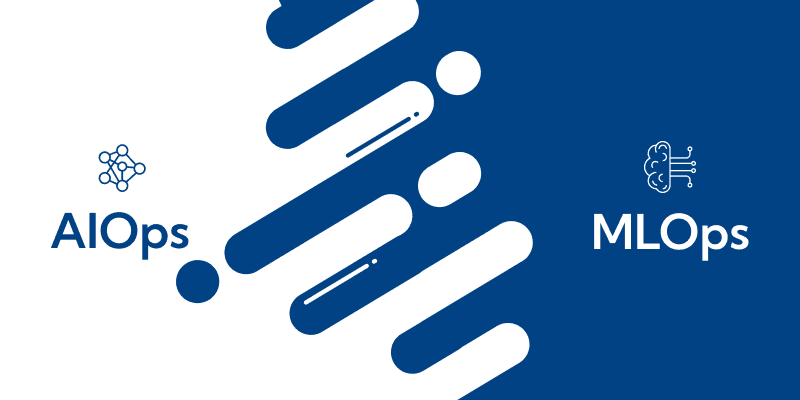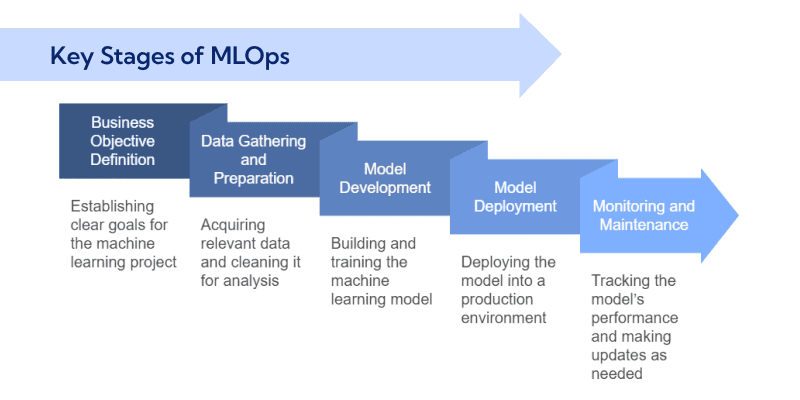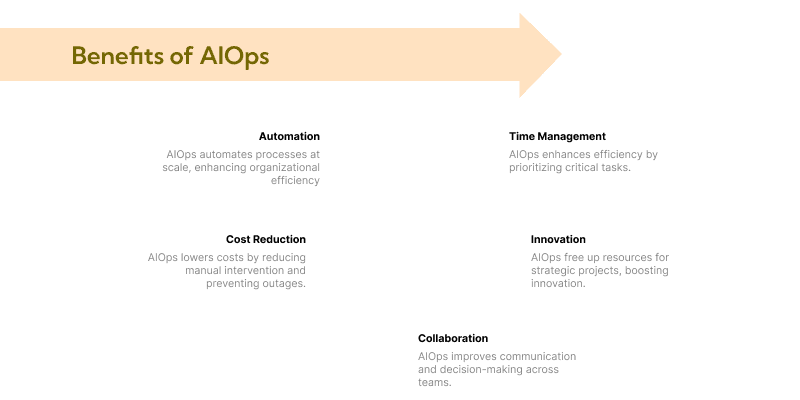AIOps vs MLOps: Understanding the Key Differences

In the world of artificial intelligence (AI) and machine learning (ML), two important strategies have emerged to streamline operations and drive efficiency: AIOps (Artificial Intelligence for IT Operations) and MLOps (Machine Learning Operations).
While they share commonalities in terms of leveraging AI and ML technologies, they serve distinct purposes within their respective domains.
This blog aims to demystify the differences and similarities between AIOps and MLOps, offering insights into how they can enhance operational efficiency and innovation across various industries.
We'll also explore their respective benefits and why organizations should consider integrating both for maximum performance and scalability.
What is MLOps?
- MLOps, short for Machine Learning Operations, is all about creating a robust system to manage the lifecycle of machine learning models. This includes everything from data preparation and model training to deployment and monitoring.
- MLOps combines principles from machine learning, DevOps, and data engineering to streamline the deployment of machine learning models into production environments.
- Machine learning models often require substantial resources and effort to maintain.
- This is where MLOps comes in, providing the framework to standardize and optimize how these models are developed, deployed, and scaled.
- The primary goal is to ensure that machine learning models can be consistently delivered to production without excessive expenditure of time, effort, or money.

Key stages of MLOps:
- Business objective definition: Establishing clear goals for the machine learning project.
- Data gathering and preparation: Acquiring relevant data and cleaning it for analysis.
- Model development: Building and training the machine learning model.
- Model deployment: Deploying the model into a production environment.
- Monitoring and maintenance: Tracking the model’s performance and making updates as needed.
What is AIOps?
- AIOps, or Artificial Intelligence for IT Operations, applies AI and ML techniques to automate and optimize IT operations processes.
- AIOps focuses on managing complex IT systems, reducing the time it takes to resolve incidents, and increasing the accuracy of issue detection and root cause analysis.
- The primary objective of AIOps is to minimize manual efforts, speed up issue resolution, and enhance the efficiency of IT operations.
- This includes handling event correlation, incident management, and predictive analytics to ensure optimal performance and system reliability.

Key AIOps use cases:
- Incident management: Automating the identification and resolution of incidents.
- Root cause analysis: Using AI to determine the causes of IT issues faster.
- Proactive performance management: Anticipating problems before they escalate into major issues.
- Automating routine tasks: Freeing up IT teams to focus on more strategic projects.

Benefits of MLOps
MLOps offers several significant advantages that streamline machine learning processes, making them faster, more reliable, and scalable.
Here’s a breakdown of some of the most important benefits:
1. Faster model validation and governance
- MLOps tools provide transparency into the entire AI lifecycle, from model creation to deployment.
- Automated reporting and governance tools ensure that models are well-documented, easily auditable, and meet compliance standards.
- This improves traceability, governance, and trust in machine learning systems.
2. Increased innovation and productivity
- MLOps enables faster development cycles, allowing data scientists and engineers to focus on innovation rather than mundane tasks like data wrangling or troubleshooting broken models.
- This enhances productivity and accelerates time-to-market for AI solutions.
3. Automation
- By automating everything from data processing to model deployment, MLOps ensures repeatability.
- This leads to efficient workflows and reduces the time needed for model updates or retraining.
4. Cost reduction
- With MLOps, there’s no need for additional personnel to manage new model versions or deploy them.
- Automation further reduces the need for manual oversight, lowering operational costs and improving resource allocation.
5. Continuous monitoring
- MLOps tools allow for ongoing monitoring of machine learning models, detecting model drift (when the model’s performance degrades) and automatically retraining them as needed to maintain optimal accuracy.

Benefits of AIOps
AIOps brings a different set of advantages to the table, particularly in the realm of IT operations. By automating many manual processes and utilizing AI for decision-making, AIOps offers benefits that significantly improve IT performance and reduce costs.
1. Better time management and priority setting
- AIOps tools help IT teams focus on the most critical tasks by filtering out irrelevant data and prioritizing incidents that have the greatest impact on business operations.
- This improves efficiency and ensures that teams focus their resources where they’re needed most.
2. Faster innovation
- By automating routine operational tasks, AIOps frees up IT teams to focus on innovation.
- With more time to devote to strategic projects, businesses can adopt new technologies and improve service offerings faster, giving them a competitive edge.
3. Enhanced collaboration
- AIOps acts as a bridge between different departments, enabling better collaboration by providing a unified view of IT operations.
- This improves communication and decision-making across teams, leading to more effective problem resolution and operational efficiency.
4. Lower IT costs
- Automation in AIOps reduces the need for manual intervention, which in turn lowers operational costs.
- Additionally, AIOps can prevent costly outages by identifying and addressing issues before they escalate.
5. Automation
- AIOps can automate processes across an entire organization, enhancing efficiency at every level.
- This scalability ensures that automation is implemented uniformly, allowing all teams to benefit equally.
AIOps vs MLOps
Best practices for implementing AIOps and MLOps
Implementing AIOps and MLOps effectively requires following certain best practices to ensure success and avoid common mistakes.
Here’s a breakdown of these practices with real-world examples.
Start small with pilot projects
- Example: Let’s say your company wants to automate IT incident resolution using AIOps. Instead of automating everything at once, start with just one system, like server health monitoring. If the automation works well, gradually expand it to other areas like database performance or network monitoring.
- Why it works: Starting small lets you test the system without big risks. You learn what works, correct mistakes, and then scale up when you're confident.
Prioritize data governance
- Example: In an MLOps project, you're using customer data to train a recommendation model. Before you proceed, set up strong data governance rules. For example, anonymize sensitive customer data, and restrict access to only necessary team members.
- Why it works: If the data is not properly governed (clean, secure, and accessible), the AI model can make poor predictions or, worse, violate privacy laws like GDPR.
Continuously monitor and retrain models
- Example: You have deployed a machine learning model that predicts customer churn. Over time, customer behavior changes, so your model’s predictions become less accurate. Set up monitoring to track the model’s performance. If the accuracy drops below 85%, retrain the model with fresh data.
- Why it works: Regularly monitoring and retraining models keeps them performing well. Without this, models become outdated and make poor predictions.
Foster collaboration between teams
- Example: A retailer using MLOps needs data scientists to build models, IT teams to deploy them, and business analysts to interpret the results. Set up regular meetings where all teams share updates, challenges, and goals. Use collaboration tools like Slack or JIRA to streamline communication.
- Why it works: When teams work together, you avoid bottlenecks and miscommunication. For instance, IT can quickly troubleshoot issues, and data scientists can ensure models are working as expected.
Automate repetitive tasks
- Example: For an AIOps project, automate tasks like server health checks and application log analysis. Set up the system to automatically resolve minor issues (like restarting a service) and only notify IT when human intervention is needed.
- Why it works: Automation saves time, reduces human error, and allows IT teams to focus on more critical tasks. It also ensures consistency in how tasks are handled.
Build feedback loops and monitor continuously.
- Example: In an MLOps setup, after deploying a recommendation engine on an e-commerce platform, collect feedback from users on the relevance of product suggestions. If users frequently rate recommendations poorly, investigate and update the model.
- Why it works: Feedback helps you refine the model or system and improve its performance over time. Without it, you're operating blindly and may miss important issues.
Plan for scalability and flexibility
- Example: A tech startup launches with a small AIOps system to automate network monitoring for a few servers. As they grow, they ensure that their system can handle monitoring hundreds of servers across different data centers. They also remain flexible, so they can adopt new tools as the company evolves.
- Why it works: Planning for scalability ensures that your system doesn’t break when the business grows. Flexibility lets you adapt to new challenges, tools, or technologies.
Conclusion
Both AIOps and MLOps are essential tools in the modern tech landscape, but they serve different purposes.
MLOps focuses on optimizing the entire machine learning lifecycle, ensuring the reliability and scalability of ML models in production environments.
AIOps, on the other hand, aims to automate and enhance IT operations, helping businesses manage their increasingly complex IT ecosystems.
The integration of both AIOps and MLOps can provide a comprehensive strategy to maximize the efficiency, scalability, and reliability of AI-driven solutions.
By using MLOps to manage machine learning models and AIOps to streamline IT operations, organizations can create a more resilient and innovative infrastructure that positions them for long-term success.
